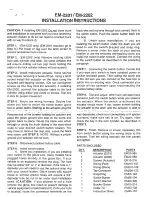
Function of the restraint system in an accident
How the restraint system works is determined by
the severity of the impact detected and the type of
accident anticipated:
R
frontal impact
R
rear impact
R
side impact
R
overturning or rollover
The activation thresholds for the components of
the restraint system are determined based on the
evaluation of the sensor values measured at vari-
ous points in the vehicle. This process is pre-emp-
tive in nature. The triggering/deployment of the
components of the restraint system should take
place in good time at the start of the collision.
Factors which can only be seen and measured
after a collision has occurred cannot play a deci-
sive role in airbag deployment. Nor do they provide
an indication of airbag deployment.
The vehicle may be deformed significantly without
an airbag being deployed. This is the case if only
parts which are relatively easily deformed are
affected and the rate of vehicle deceleration is not
high. Conversely, an airbag may be deployed even
though the vehicle suffers only minor deformation.
If very rigid vehicle parts, such as longitudinal
members, are hit, the vehicle deceleration may be
high enough for this to happen.
Depending on the detected deployment situation,
the components of the restraint system can be
activated or deployed independently of each other:
R
Seat belt tensioner: frontal impact, rear
impact, side impact, overturning, rollover
R
Driver's airbag, front passenger airbag: frontal
impact
R
Side airbag: side impact
R
Window airbag: side impact, overturning, roll-
over, frontal impact
The co-driver airbag can only be deployed in the
event of an accident if the PASSENGER AIR BAG
OFF indicator lamp is off. If the co-driver seat is
occupied, make sure, both before and during the
journey, that the status of the co-driver airbag is
correct (
/
page 36).
&
WARNING Risk of burns from hot airbag
components
The airbag parts are hot after an airbag has
been deployed.
#
Do not touch the airbag parts.
#
Have a deployed airbag replaced at a
qualified specialist workshop as soon as
possible.
Mercedes-Benz recommends that you have the
vehicle towed to a qualified specialist workshop
after an accident. Take this into account, particu-
larly if a seat belt tensioner is triggered or an air-
bag deployed.
If the seat belt tensioners are triggered or an air-
bag is deployed, you will hear a bang, and a small
amount of powder may also be released:
R
the bang will not generally affect your hearing.
R
in general, the powder released is not hazard-
ous to health but may cause short-term breath-
ing difficulties to persons suffering from
asthma or other pulmonary conditions.
Provided it is safe to do so, leave the vehicle
immediately or open the window in order to
prevent breathing difficulties.
Seat belts
Protection provided by the seat belt
Always fasten your seat belt correctly before start-
ing a journey. Only a seat belt which is worn cor-
rectly can provide the intended level of protection.
&
WARNING Risk of injury or death due to
incorrectly fastened seat belt
If the seat belt is not worn correctly, it cannot
perform its intended protective function.
In addition, an incorrectly fastened seat belt
can also cause injuries, for example, in the
event of an accident or when braking or chang-
ing direction suddenly.
#
Always ensure that all vehicle occupants
have their seat belts fastened correctly
and are sitting properly.
Always observe the instructions about the correct
driver's seat position and adjusting the seat
(
/
page 70).
30
Occupant safety
T447 0414 02
Содержание EQV 2021
Страница 1: ...EQV Owner s Manual T447 0414 02 ...
Страница 7: ...T447 0414 02 ...
















































